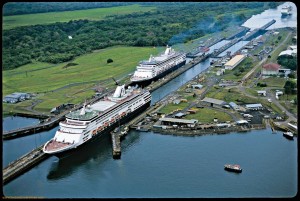This past week, Panama culminated a month of celebrations on the 100th anniversary of the Panama Canal. Foreign dignitaries, local government officials, entertainers, and throngs of tourists all flocked to the locks to commemorate this historic event, and celebrate the continued growth of Panama’s engineering masterpiece. It was a way to not only celebrate the achievements made via the Canal, but also to honor the thousands of men and women who helped construct it; many of whom died in the long and arduous process. Panama has only had full sovereign control over the Canal for around 15 years, but has seen their country transform in that time, thanks largely to the economic benefits of the waterway.
A Man, a Plan, a Canal, Panama
The Panama Canal was originally a French project, but after years of losing money, workers, and support from back home, the Europeans abandoned the project, which then lay dormant for nearly 20 years. The United States, lead by Teddy Roosevelt saw its potential, and quickly stepped in, making an arrangement with the Panamanian government for complete sovereignty over the Canal, and its immediate surrounding areas. With the incentive of gaining independence from Colombia, and the thought that the country could benefit economically from a US partnership, Panama agreed to perpetual sovereignty of the area. Ten years later, the Canal was completed.
Conditions during construction were brutal, and thousands of lives were lost during the process. However, building the Canal is what helped populate Panama, and with the amount of foreign labor brought in, sewed the seeds that make Panama such an ethnically diverse country today. The Canal was the first man-made waterway to connect the Atlantic with the Pacific Ocean, opening trade routes that effectively shortened a trans-continental voyage by 2 weeks. Business was booming from the start, and generated billions of dollars for the US government. In 1977, US President Jimmy Carter and Panama President Omar Torrijos, signed an agreement which would give full control back to Panama on December 31, 1999.
Celebrating a New Era of the Panama Canal

The upgraded Canal will only add to economic growth in the nation, and is a big factor in current investment in the nation, which has averaged nearly double-digit growth in the past five years. It creates jobs, lowers material costs to local consumers, and pumps billions of dollars into the local economy annually. And this is something that hasn’t gone unnoticed to foreign investors. Panama is certainly sitting on the cusp of becoming a regional economic powerhouse, and they’re betting on the Canal to help get them there.